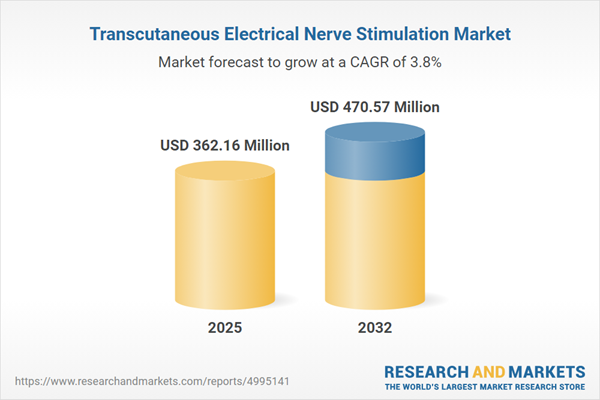Speak directly to the analyst to clarify any post sales queries you may have.
The transcutaneous electrical nerve stimulation (TENS) market continues to gain traction as clinical leaders and executive stakeholders seek nonpharmacological pain management solutions. This analysis equips senior decision-makers with the latest strategic insights to support confident investments in a sector marked by evolving innovation, shifting regulations, and growing global relevance.
Market Snapshot: Transcutaneous Electrical Nerve Stimulation Market
The global transcutaneous electrical nerve stimulation market expanded in 2024 and 2025, reflecting a projected compound annual growth rate (CAGR) of 3.81% and an expected market value of USD 470.57 million by 2032. This sustained momentum is driven by rising demand for alternatives to opioid therapies, continuous product advancements, and greater stakeholder awareness around effective chronic pain management. As a result, noninvasive strategies are gaining widespread acceptance among healthcare providers, home care professionals, and end users worldwide.
Scope & Segmentation
This report delivers an in-depth evaluation of the TENS device landscape with detailed segmentation to help senior executives identify growth opportunities and risk areas across the industry:
- Product Types: Portable and stationary devices address a spectrum of care environments and patient mobility needs.
- Mode: Acupuncture, burst, conventional, and modulated operations enable versatile therapy protocols to suit various medical practices and patient profiles.
- Battery Types: Disposable and rechargeable options reflect advancements in sustainability and user preference, optimizing device lifecycle management for organizations.
- Applications: Devices support aesthetic treatments, broad pain management—including acute, chronic, and neuropathic indications—physiotherapy, and sports medicine, highlighting their versatility in both clinical and wellness sectors.
- End Users: Use cases span clinical practices, home care, hospitals, and physiotherapy centers, showcasing the adaptability of execution models and patient engagement in diverse settings.
- Regions: Coverage extends to the Americas, Europe, Middle East, Africa, and Asia-Pacific, incorporating developed and emerging economies with explicit attention to local regulations, economic conditions, and varied healthcare delivery frameworks.
- Leading Companies: Competitive analysis includes organizations such as Medtronic plc, DJO Global, Inc., ConMed Corporation, Omron Healthcare Co., Ltd., Zynex, Inc., BTL Industries d.o.o., NeuroMetrix, Inc., CeFAR AB, BioMedical Life Systems, Inc., and Enraf Nonius B.V., identifying strategic differentiators and innovation initiatives among market leaders.
Key Takeaways for Decision-Makers
- Adoption of portable, user-friendly TENS solutions enables therapy in home and remote settings, enhancing patient access and adherence to treatment protocols.
- Device flexibility and expanded operational modes have broadened the appeal of TENS devices, making them relevant for clinical, outpatient, and aesthetic applications.
- Collaboration between device manufacturers, software developers, and care providers accelerates improvements in connectivity, real-time monitoring, and highly customized treatment programs for multiple indications.
- Emerging policies and new reimbursement structures are facilitating adoption and helping to establish consistent standards for telemedicine and remote therapy delivery.
- Regional differences in regulatory processes and funding models necessitate tailored market-entry strategies, particularly in new or fast-growing economies where opportunities and risks are distinct.
- Increasing M&A and licensing activities are shaping a consolidated market landscape, enabling organizations to scale more efficiently and promote wider adoption of advanced technologies.
Tariff Impact and Supply Chain Adjustment
The 2025 introduction of United States tariffs on imported medical devices elevated costs throughout the TENS equipment supply chain. In response, manufacturers developed dual sourcing strategies, built regional alliances, and shifted production domestically to alleviate pricing volatility. Distributors adjusted pricing structures, while all supply chain participants increased their focus on compliance, procurement optimization, and scenario-based planning. Analytical decision tools for supply chain resilience have become critical for maintaining competitiveness in a fluctuating regulatory environment.
Methodology & Data Sources
This analysis draws from primary interviews with executives, clinical leaders, and supply chain specialists to ensure executive-level perspectives. Secondary research includes regulatory filings, peer-reviewed journals, industry publications, and patent records. Strategic planning frameworks, such as SWOT, Porter’s Five Forces, and scenario mapping, inform all recommendations and contextual analysis.
Why This Report Matters
- Offers actionable insights for executives considering investments or market expansion opportunities in the transcutaneous electrical nerve stimulation sector.
- Enables effective benchmarking for innovation, go-to-market strategies, and channel development in line with regulatory and operational shifts worldwide.
- Prepares leaders for economic, policy-driven, and supply chain disruptions, supporting resilient strategic planning in an evolving industry context.
Conclusion
The transcutaneous electrical nerve stimulation market presents growth potential for organizations focused on technological adoption, regulatory compliance, and partnership-driven innovation. In-depth analysis in this report enables business leaders to anticipate evolving trends and position for sustainable success.
Additional Product Information:
- Purchase of this report includes 1 year online access with quarterly updates.
- This report can be updated on request. Please contact our Customer Experience team using the Ask a Question widget on our website.
Table of Contents
3. Executive Summary
4. Market Overview
7. Cumulative Impact of Artificial Intelligence 2025
List of Figures
Samples

LOADING...
Companies Mentioned
The key companies profiled in this Transcutaneous Electrical Nerve Stimulation market report include:- Medtronic plc
- DJO Global, Inc.
- ConMed Corporation
- Omron Healthcare Co., Ltd.
- Zynex, Inc.
- BTL Industries d.o.o.
- NeuroMetrix, Inc.
- CeFAR AB
- BioMedical Life Systems, Inc.
- Enraf Nonius B.V.
Table Information
| Report Attribute | Details |
|---|---|
| No. of Pages | 198 |
| Published | October 2025 |
| Forecast Period | 2025 - 2032 |
| Estimated Market Value ( USD | $ 362.16 Million |
| Forecasted Market Value ( USD | $ 470.57 Million |
| Compound Annual Growth Rate | 3.8% |
| Regions Covered | Global |
| No. of Companies Mentioned | 10 |









